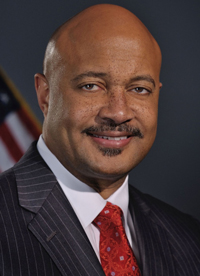By CURTIS HILL
Indiana Attorney General
 The racism we Black Americans experience isn’t always visible to the naked eye. Many Black Americans who have been pulled over for “speeding” or for “tinted windows” know what I’m talking about. Many Black Americans who have been surveyed closely by security guards at shopping malls know what I’m talking about.
The racism we Black Americans experience isn’t always visible to the naked eye. Many Black Americans who have been pulled over for “speeding” or for “tinted windows” know what I’m talking about. Many Black Americans who have been surveyed closely by security guards at shopping malls know what I’m talking about.
Most Black Americans, unfortunately, know exactly what I’m talking about.
Recently, though, Dre Abram experienced racism that was neither vague nor subtle. And it was caught on video for the world to see.
Abram, a Black man who has a YouTube channel with nearly 100,000 subscribers, was filming a video with a Black friend in Scottsdale, Ariz. During the filming, a man later identified as Paul Ng approached the duo and asked to see “what you guys are taking pictures of.” Then Ng explained that the neighborhood had recently experienced “problems.”
So far, one might conceivably believe Ng was acting in good faith.
But then Ng said, with a straight face, “I’m a racist.”
And he told the two Black men – on camera, remember – that his neighborhood was a “no-n***** zone.”
Ordinarily, I try to reserve immediate judgment on video clips that allegedly demonstrate racism or discrimination. In many of these incidents, it is worth attempting to understand what may have happened before the camera was turned on.
This is not one of those incidents. Ng’s actions were prompted by his obvious contempt for Black people, and they led to him being fired from his job and arrested for disorderly conduct.
While most would agree that this unfortunate altercation had a positive ending, it’s important that we look at the bigger picture. The fact that Ng felt comfortable enough to identify himself as a racist and to use a racist slur while being filmed by a Black man is an astonishing indictment on the state of race relations in America.
How did we get here? How have we reached a point where Ng, and others like him, feel it’s acceptable to proclaim their racist beliefs?
Some might say the prevalence of attitudes like Ng’s is simply evidence that the United States of America is inherently racist.
I reject that argument.
We also often hear that police actions taken against unarmed Black Americans prove the essentially racist nature of U.S. society.
I reject that argument, as well.
Yet, there can be no doubt that too many folks possess attitudes all too similar to Ng’s.
And we should find it understandable if many Black Americans, upon seeing the killings of individuals such as George Floyd and Ahmaud Arbery, have the unsettling feeling that the victims would still be alive if they were White.
But America’s police are not the architects of Paul Ng’s racism. And America, as a whole, is not responsible for the racism that permeates the mindset of Paul Ng.
Instead, I truly believe that in their hearts, most Americans are shocked and dismayed by racist language such as Ng’s. And I truly believe that most Americans – including police – are horrified by unjust killings of Black individuals at the hands of police officers.
As a country, we have worked steadily to enact laws and reforms that seek to ensure that America is a land where everyone, regardless of their skin color, is treated equally. And we should continue to advocate for such measures wherever they are appropriate.
The bottom line, though, is that no amount of legislation can change what’s inside the hearts of hateful people. Something is broken inside the hearts of Ng and others like him.
So how do we change their hearts?
I don’t have a definitive answer. But I know where progress can start.
It starts with open dialogue. Dialogue about how we Black Americans feel in 2020. Dialogue about how the beliefs of a small number of people can hurt a great number of people. Dialogue about where those beliefs originate. Dialogue about how we can alter the minds of those infected with hate.
I have sought to initiate this dialogue in the Hoosier state. In October, I hosted a “Bridge Forum” with the Hero Zona Foundation that brought together prominent government and law enforcement officials to address systemic racism. It included my own “fireside chat” with Dr. Benjamin Chavis Jr., a longtime civil rights leader who in 1971 was one of the “Wilmington Ten” – a group of young people wrongfully convicted of arson and conspiracy.
Honest conversations like these, among key community stakeholders, is how we will ease these tensions.
I would like to see these structured conversations implemented throughout the country.
We cannot achieve unity without understanding what divides us.
Paul Ng is the physical manifestation of that division. He is a clear reminder that this hatred still exists. It persists in many other Americans, too – just not so obviously. Those are the people we must reach. Those are the hearts we must heal.
We have a long way to go. But through consistent, productive efforts, we will succeed.
